While most people have had a brownie, it seems like few people have ever had the brownie’s less popular albino cousin, the blondie. Little does anyone know, though, that the blondie and brownie are caught up in a strange case of stolen identity. The blondie was backstabbed by the brownie in it’s infancy. What do I mean?
Picnik Austin: Where My Life Changed Forever
On my first visit to Austin, Jeff introduced me to a place that changed my dessert life forever: Picnik Austin. Not only could I eat all of their food without suffering an allergic reaction, but their blondies…woah.
I can, without a doubt, say that their blondies are one of the most amazing things that I’ve ever tasted. Even though they are made with dairy which makes me break out, I will gladly suffer the consequences in order to experience the nirvana that is the blondie.
We were only in Austin for four days and I quite literally ate 12 blondies during our stay. Let’s see, carry the one…THAT MEANS THAT I ATE THREE BLONDIES PER DAY AND I HAVE NO REGRETS!
While I hadn’t been too familiar with the blondie prior to Picnik, I ventured on a mission to figure out how to recreate Picnik’s incomparable blondies once we returned home. What I didn’t expect to do while working on a recipe was to challenge everything I thought I knew about brownies. By researching the history of the blondie, I realized that you couldn’t think about it without first considering the “brownie.”
Why did I put “brownie” in quotes, you ask? You’ll understand soon enough…and no, I’m not talking about a certain “special brownie,” ya stoner.
The History of Blondies
It turns out that the sumptuous and decadent treat that we know of as the blondie actually predates the brownie. For some reason, though, the name “brownie” also predates the brownie. Whhhaaaattt?! How is that possible?!
Allow me to fill you in on a little secret: the blondies that we know and love are actually…the original recipe for brownies. *cue lightning*
Yes, the original name “brownie” was meant to describe the dessert that is now known as the blondie. As such, the original recipe for the “brownie” did not contain chocolate. So, one has to wonder, where did the “brown” part of “brownies” come from? I really hope I don’t regret the answer.
Palmer House Hotel: Birthplace of the Brownie?
As I mentioned in my history of the daiquiri post, it can be difficult to pin down exactly who first created a recipe.
According to the Palmer House Hotel, one of the oldest continuously operating hotels in the country, they claim that it was within their very own kitchen that the brownie was conceived.
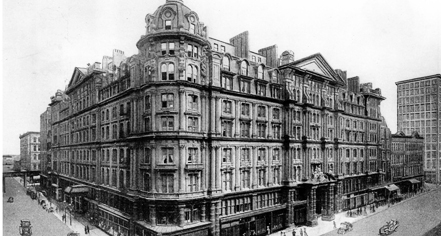
Constructed in 1870, the Palmer House Hotel was a wedding present from millionaire Potter Palmer (1826-1902) to his new bride, Bertha Potter Palmer (1849-1918). This first hotel, however, burnt down in the Fire of 1871 that decimated a large part of Chicago.
Never one to be bested, Potter Palmer built his wife a brand new hotel, even more gaudy and ornate than the previous one.
The new 7-story hotel was filled with elaborate mosaics and rich Italian marbles, which people alternately mocked and fawned over. After all was said and done, the new hotel, which was finished in 1875, allegedly cost a whopping $13 million, which equates to over $306 million today! This hotel was intended to serve not only as a place for brief stays, but also as permanent housing for wealthy residents. This would prove to be quite a fruitful investment during the World’s Columbian Exposition.

Bertha Potter Palmer
The year was 1893. The World’s Columbian Exposition was in full-swing. Bertha Potter Palmer, who was President of the Board of Lady Managers, was in a bind. She was in charge of coordinating the boxed lunches that were to be brought to the Women’s Building, but there was a problem. While the rest of the meal had been orchestrated, there was no dessert! She thought long and hard about it….Hmm, rice pudding? No, too messy. Cake? No, too extravagant for lunch.
Exasperated, she asked the pastry chefs at the Palmer House to assist with her dilemma. They came to the rescue with their culinary genius! They, allegedly, created a small cake-like bar that they topped with an apricot glaze and chopped walnuts. While these resembled modern-day brownies in virtually every aspect (minus the apricot), they weren’t yet called brownies.
In fact, it wasn’t until a few years later that these bars would get their name, thanks to Boston-based culinary whiz, Fannie Farmer.
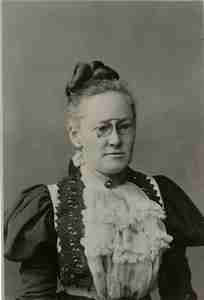
Fannie Farmer & Her Cookbook
In 1896, Fannie Farmer (1857-1915) published her iconic cookbook, The Boston Cooking-School Cookbook. This cookbook is a piece of culinary history for two distinct reasons. The first reason is because hers is the first printed cookbook to standardize measuring spoons and cups. The second is because she is credited with publishing the first printed recipe for the brownie. Though, it’s not the chocolatey, fudgey brownie that you think.
Fannie Merritt Farmer was born in 1857 in Boston, Massachusetts. When she was 16, she suffered a paralytic stroke leaving her unable to walk as well as unable to continue her education. Because of this, she began cooking for her mother’s boarding house. The boarding house became known for it’s exemplary cooking, leading Fannie to pursue an education at the famed Boston Cooking School.
At age 30, Farmer enrolled in the Boston Cooking School. She rose through the ranks from student to assistant director before becoming head of the Boston Cooking School in 1894. It was two years later when she published her legendary cookbook.
In the inaugural publication of The Boston Cooking-School Cookbook, Farmer’s recipe for brownies looks quite similar to that of the modern-day blondie:
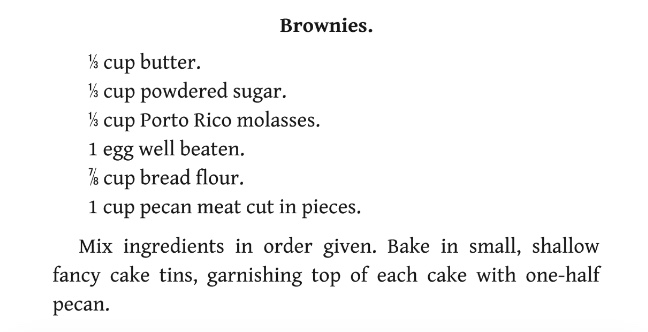
Let’s see, it looks like we have all the typical ingredients for a brownie. We have butter, powdered sugar, molasses…wait a minute. So, it was molasses that gave the bars their color and, in turn, their name “brownies!” Life makes sense again!
It wasn’t until the 1906 republication of Farmer’s cookbook that the recipe for brownies shifted into what we are more familiar with now: a chocolatey, fudgy delight.

Cheap ingredients like molasses fell out of favor in the early 1900s, so chefs began to substitute brown sugar for the molasses in the original brownie recipe. This gave the bars a butterscotch flavor, leading them to be referred to as “butterscotch brownies.”
As time progressed and chocolate became more attainable to the masses, the chocolate brownie soared in popularity. The butterscotch brownie, however, got left behind in the dust. While it was still popular, it didn’t receive the same amount of love and affection that the brownie would get..there, there, blondie. I still love you!
From Butterscotch Brownie to Blondie
By the 1950s, cookbook authors began calling butterscotch brownies “blonde brownies.” After that, though, nothing too earth-shattering appears to have happened to the blondie…that is, until the 1980s.
According to food historians, it was sometime in the 1980s that the term “blondie” was used in reference to these chocolate-less cake-like bars. I never thought I’d say this, but thank goodness for the 1980s!
While blondies have never fully reached the zenith of popularity of chocolate brownies, they are anything but a distant memory of the past. Pastry chefs continue to innovate and, today, you can get your blondie with nuts, chocolate chips, or even fruit! (Honestly, though, if you’re putting fruit in your blondie, you may as well eat a Nutri-Grain bar. #sorrynotsorry)
The Recipe
Since I haven’t been able to find a place that has gluten-free blondies as amazing as Picnik’s, I’ve had to improvise and create my own recipe. While nothing can compare to Picnik’s exquisite blondies, I hope this recipe can somewhat satisfy your cravings until you can get your hands on the buttery goodness that is the Picnik blondie!
Print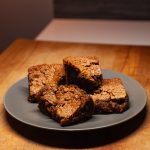
Gluten-Free, Paleo & Vegan Blondies
- Prep Time: 10 minutes
- Cook Time: 30 minutes
- Total Time: 40 minutes
- Yield: 9 blondies 1x
- Category: Dessert
- Method: Baking
- Cuisine: American
Description
If you’ve ever tried the heavenly blondies at Picnik in Austin, you’ll know how addictive they are! Hopefully this recipe can stave off your cravings until the next time you can make it to Picnik!
Ingredients
- Organic refined coconut oil
- 2 cups organic almond flour
- 1 ½ tsp. baking powder
- 1 tsp. organic ground cinnamon
- ½ tsp. salt
- ½ tsp. baking soda
- ¾ cup organic unrefined coconut oil, melted
- 1 ½ cups organic coconut sugar
- 6 tbsp. non-dairy milk (I used Califia Farms Better Half)
- 4 tbsp. organic cashew butter
- 2 tbsp. organic vanilla extract
- ⅔ cup dairy-free semi-sweet chocolate chips
Instructions
- Preheat your oven to 350°F.
- Grease an 8” x 8” glass dish with refined coconut oil. (Make sure you grease it really well or else your blondies will stick to the dish and then you’ll have to make out with some glass to get all of your blondies.)
- In a medium bowl, whisk together the almond flour, baking powder, cinnamon, salt, and baking soda until combined.
- In a large bowl, beat the melted coconut oil, coconut sugar, non-dairy milk, cashew butter, and vanilla extract until well combined. Then, slowly beat in your flour mixture.
- Stir in your chocolate chips and then pour your batter into your prepared dish.
- Bake for about 25-30 minutes or until the edges are lightly browned.
- Once cooled, cut into squares and serve.
- Sing “Heart of Glass” in honor of Blondie while eating your blondies and enjoying being a cannibal.
Keywords: Desserts, Blondies, Brownies, History of Food
Show Me Your Blondies!
Tag me on Instagram @amara_andrew with the hashtag #historyoffood so I can see your delicious creations! 🙂

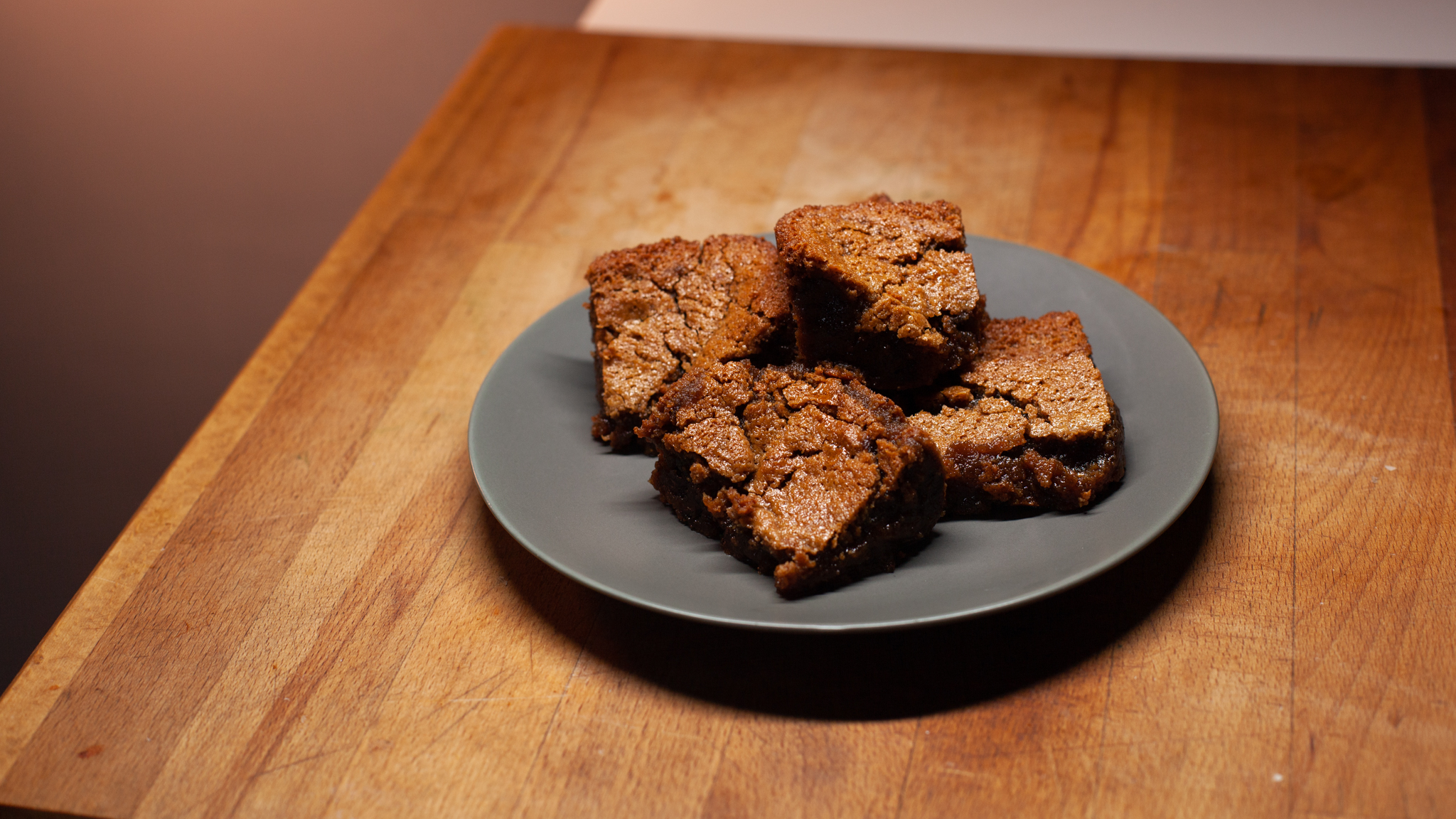
Leave a Reply